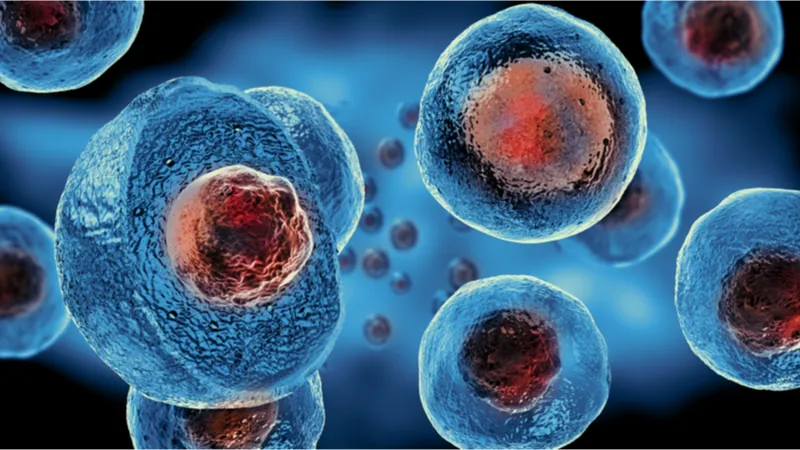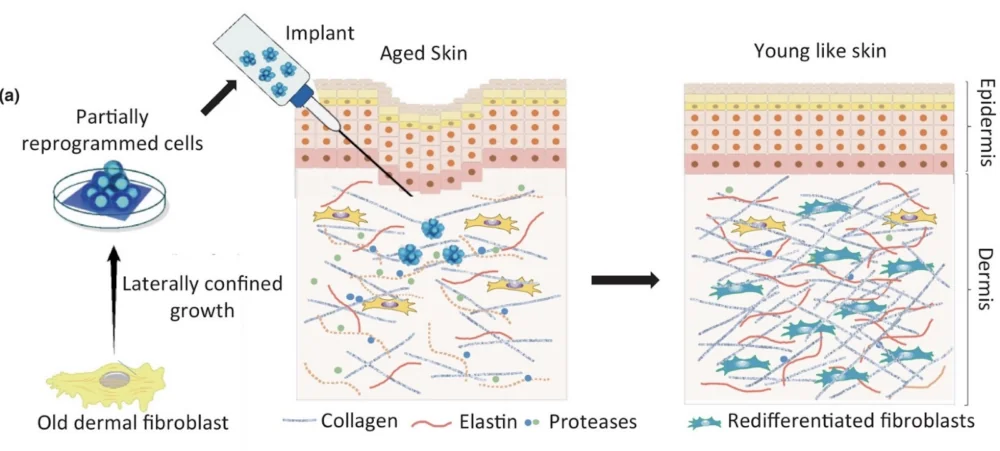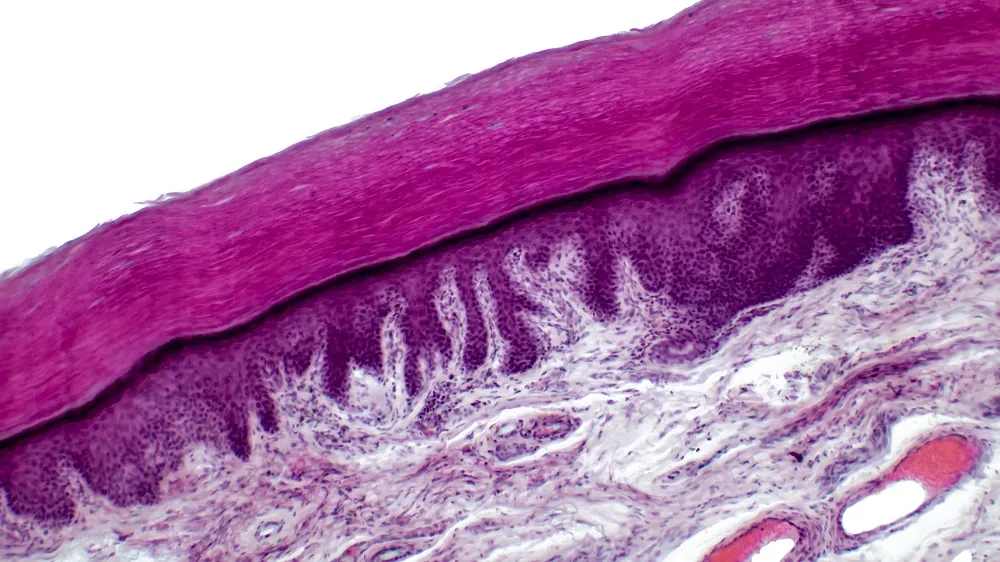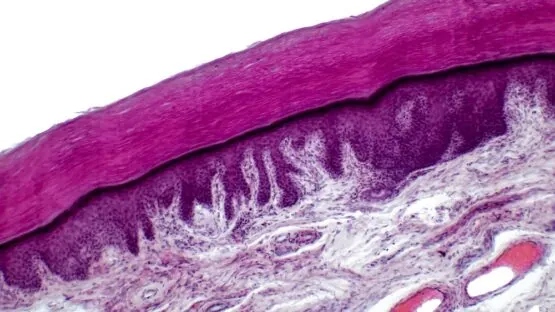Scientists have found a way to reprogram fibroblasts without chemicals by culturing them on a surface with specific mechanical properties. Transplanted into aged skin, those cells boosted rejuvenation in a human tissue model [1].
We’ve all got skin in the game
Skin aging might not be the deadliest part of organismal aging, but it certainly is one of the most conspicuous. For millennia, people have tried to slow down skin aging, and recently, various stem cell therapies have been proposed due to the fact that those cells drive rejuvenation of tissues [2].
However, harvesting stem cells is not easy. Stem cells also age, losing their “stemness” in the process, which research experiments have alleviated by using fully or partially reprogrammed cells. This cellular reprogramming allows the production of stem cells out of somatic cells and is accompanied by considerable rejuvenation. However, it is an intricate process, and reprogramming people’s cells with transcription factors might increase the risk of cancer.

Read More
More effective ECM remodeling
A while back, a group of scientists found that fibroblasts that are grown on a surface with specific mechanical properties undergo efficient non-chemical partial reprogramming, which leads to their rejuvenation. Those cells then redifferentiate back into functional fibroblasts that are better at producing elements of the extracellular matrix (ECM) and have less DNA damage than prior to reprogramming [3]. In this new paper published in Aging Cell, the same researchers report on the effects of implanting partially reprogrammed fibroblasts produced in this manner in an in vitro skin model.
Fibroblasts were obtained from a 75-year-old donor and an 11-year-old donor. Some of the cells from the old donor underwent partial reprogramming. Then, old cells, young cells, and old reprogrammed cells were transplanted into a skin model that structurally and physiologically mimicked aged human skin.
10 days after implantation, partially reprogrammed cells were producing as much collagen I as implanted young cells and much more than implanted old cells. Interestingly, with two other important ECM-remodeling proteins, elastin and fibronectin, the results were even more impressive: the partially reprogrammed cells far outperformed both young and old cells.

To be effective, fibroblasts must migrate upon transplantation, spreading out and ensuring homogenous skin rejuvenation. Partially reprogrammed cells spread uniformly into a larger area than old cells, thus ensuring more effective ECM remodeling.
Better wound healing
The researchers also tested partially reprogrammed cells in their skin wound model by making a deep cut. Cell implantation led to much more effective wound healing compared to no implantation at all. Interestingly, the transplanted fibroblasts produced a lot of αSMA, a protein that participates in wound closure. When transplanted into intact skin, partially reprogrammed fibroblasts did not produce αSMA. This shows that the transplanted cells were “aware” of their surroundings and could effectively perform various fibroblast functions.
In the wound healing model, partially reprogrammed cells exhibited a gene expression signature that significantly differed from old cells. Most differentially expressed genes (more than 200) were upregulated. Those included ECM-related genes, cytoskeleton-related genes, and wound response genes. The changes in gene expression closely resembled those happening during wound healing in vivo.
Finding ways to counteract skin aging is important for non-aesthetic reasons. Skin cancers are highly prevalent [4], even if less deadly than most other cancer types. Moreover, skin aging was found to drive inflammaging, the sterile age-related inflammation that has been implicated in various processes of aging. It would be interesting to see the results of an experiment similar to the one described here in vivo, which will probably be the next step.
In summary, our study demonstrates the potential of implanting mechanically reprogrammed aged fibroblasts for tissue regeneration and wound healing. We utilized an in vitro FT skin model that mimics physiologically relevant young and aged skin tissue. As expected, implanting only aged fibroblasts resulted in minimal ECM regeneration and remodeling. However, when the PR cells were implanted, they underwent redifferentiation, leading to a highly rejuvenated fibroblastic cell state. This rejuvenation was evident through the expression of fibroblast markers like vimentin and the deposition of increased ECM, including collagen I, elastin, and fibronectin. Furthermore, the rejuvenated cells demonstrated enhanced migratory capacity compared to aged fibroblasts, indicating their tissue regenerative potential over larger distances. Our results suggest that implanting PR cells in aged tissues could offer highly regenerative outcomes with both increased cell numbers and spatial distributions.
Literature
[1] Roy, B., Pekec, T., Yuan, L., & Shivashankar, G. V. (2023). Implanting mechanically reprogrammed fibroblasts for aged tissue regeneration and wound healing. Aging Cell, e14032-e14032.
[2] Ojeh, N., Pastar, I., Tomic-Canic, M., & Stojadinovic, O. (2015). Stem cells in skin regeneration, wound healing, and their clinical applications. International journal of molecular sciences, 16(10), 25476-25501.
[3] Roy, B., Yuan, L., Lee, Y., Bharti, A., Mitra, A., & Shivashankar, G. V. (2020). Fibroblast rejuvenation by mechanical reprogramming and redifferentiation. Proceedings of the National Academy of Sciences, 117(19), 10131-10141.
[4] Garcovich, S., Colloca, G., Sollena, P., Andrea, B., Balducci, L., Cho, W. C., … & Peris, K. (2017). Skin cancer epidemics in the elderly as an emerging issue in geriatric oncology. Aging and disease, 8(5), 643.




